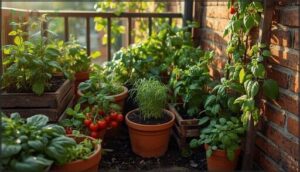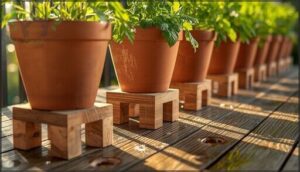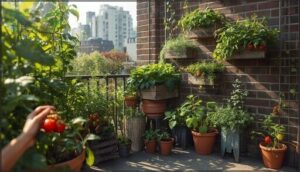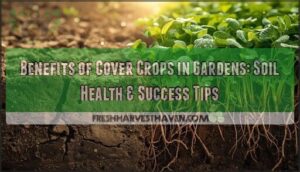This site is supported by our readers. We may earn a commission, at no cost to you, if you purchase through links.
You don’t need a sprawling backyard to grow your own food. A sunny balcony, a small patio, or even a bright windowsill can become a productive garden with the right approach. Vegetable gardening in small spaces has exploded in popularity as urban dwellers discover they can harvest fresh tomatoes, crisp lettuce, and fragrant herbs from just a few square feet.
The secret lies in working smarter with containers, vertical structures, and compact plant varieties that thrive in tight quarters. With some planning and the right techniques, you’ll transform limited space into a year-round source of homegrown vegetables that taste better than anything from the grocery store.
Table Of Contents
- Key Takeaways
- Planning Your Small Space Vegetable Garden
- Selecting Crops for Limited Spaces
- Choosing and Preparing Containers
- Maximizing Productivity in Small Gardens
- Essential Care and Maintenance Tips
- Frequently Asked Questions (FAQs)
- What vegetables can you grow in small spaces?
- What is the best layout for a small vegetable garden?
- How do you grow vegetables in small space?
- What vegetables take the least amount of space to grow?
- How do you grow a lot of vegetables in a small space?
- How do you layout a small vegetable garden?
- What leafy vegetable needs only a small space to grow?
- Should you include a vegetable garden in your small garden ideas?
- How to grow vegetables in small spaces?
- What are small vegetable garden ideas?
- Conclusion
Key Takeaways
- Small space gardens thrive when you match plant selection to available sunlight (6-8 hours for fruiting crops, 3-4 hours for leafy greens) and choose compact varieties like ‘Patio’ tomatoes or ‘Pixie’ cabbage that deliver full-sized yields in tight quarters.
- Vertical gardening techniques like trellises and wall planters can multiply your harvest by up to 14 times per square foot compared to traditional beds, while succession planting every 2-3 weeks extends your growing season by 8-12 weeks.
- Container gardening success depends on proper drainage (at least one hole per pot prevents 70% of failures), adequate container size (5 gallons minimum for tomatoes and peppers), and frequent watering since containers dry out faster than ground beds.
- Strategic companion planting (like tomatoes with basil) reduces pests by up to 36%, while regular pruning and harvesting can boost yields by 15-35% in small spaces without needing additional square footage.
Planning Your Small Space Vegetable Garden
Planning your small space vegetable garden starts with understanding what you’re working with. You need to look at how much space you have, how much sunlight it gets, and what type of setup makes the most sense for your situation.
Let’s break down the key steps to get your garden off to a strong start.
Assessing Available Space and Sunlight
Before you plant anything, measure your space and track how much sunlight it gets throughout the day. Most vegetables need 6–8 hours of direct sun. Leafy greens can handle 3–4 hours, but tomatoes and peppers won’t produce without full sun. South-facing balconies get the most light. Watch for shadows from buildings and map your microclimate to make the most of sunlight exposure in small spaces.
Sunlight is essential, as plants need it to perform the photosynthesis process.
Choosing The Best Garden Type (Containers, Raised Beds, Vertical)
Once you know your sunlight situation, pick a garden style that fits your space. Container gardening works well on balconies and patios. You can move pots around as needed. Raised beds need more room but offer better drainage and soil control. Vertical gardening maximizes tight spaces by growing upward. Soil fertility is a key consideration in container gardens because nutrients are quickly depleted.
Consider these factors when choosing:
- Space considerations – Containers fit anywhere; raised beds need 4-foot-wide areas; vertical systems use walls
- Maintenance needs – Containers dry out faster and need frequent watering
- Yield expectations – Vertical gardens can produce 50–100 times more per square foot than traditional methods
Your budget matters too. Containers cost less upfront than building raised beds, though costs balance out by year two.
Designing Efficient Garden Layouts
Now that you’ve picked your garden type, map out a space-saving garden layout that makes every inch count. Proper planning transforms your compact garden into a productive powerhouse.
Start with these layout metrics:
| Garden Feature | Recommended Size | Why It Matters |
|---|---|---|
| Raised bed width | 4 feet | Easy reach from both sides |
| Pathway width | 2–4 feet | Comfortable access for watering |
| Bed height | 6–8 inches minimum | Boosts yields by 25% |
| Plant spacing | Tight but not touching | Suppresses weeds by 60% |
Use vertical strategies whenever possible. Trellises and wall planters can triple your growing space compared to flat beds. That’s a real advantage when you’re working with a balcony or small patio.
Get the most out of your space further with intercrop methods. Plant fast-growing lettuce between slower tomatoes. You’ll harvest the greens before tomatoes need that room. This approach increases combined yields by 18% compared to growing crops separately.
Succession planting keeps your beds producing all season. Divide your space into three or four sections. Plant new crops every two weeks. You’ll extend your harvest window by 8–12 weeks and always have fresh vegetables ready.
Don’t leave gaps between plants. Those empty spots invite weeds and waste precious real estate. Tight spacing in raised beds creates a natural canopy that conserves moisture and blocks unwanted growth.
Remember that maximizing your small space isn’t about cramming plants together randomly. It’s about strategic placement that lets each plant thrive while producing the most food possible from your available area.
Maximizing small space gardens requires strategic placement that lets each plant thrive, not random cramming
Selecting Crops for Limited Spaces
Choosing the right crops makes all the difference when you’re working with limited space. Some vegetables thrive in containers and small beds while others will take over your entire setup.
Let’s look at which plants give you the best results without hogging all your room.
Compact and Dwarf Vegetable Varieties
When you’re choosing compact vegetable varieties for container gardening, you’ll discover space efficiency that traditional plants can’t match. Market demand has pushed breeding advancements forward, creating dwarf variety yields that rival full-sized crops.
- ‘Patio’ tomatoes reach just 24 inches tall yet deliver multiple harvests
- ‘Pixie’ cabbage forms 5-inch heads with only 10-inch spacing needed
- ‘Fairy Tale’ eggplant matures in 63 days on 18-24 inch plants
These compact varieties also offer ornamental appeal for small spaces.
Fast-Growing Crops for Quick Harvests
For quick returns on your space investment, radishes and leafy greens like arugula deliver harvests in just 25–30 days. Spinach and lettuce mature within 30–40 days, while bush beans reach your table in 45–55 days. Root crops like baby carrots take only 30 days too.
These FastGrowing Crops enable succession planting every 2–3 weeks, doubling your yields throughout the season.
Best Herbs for Container Growing
Herbs thrive in containers and deliver big flavor from tiny spaces. Basil produces up to 0.45 kg per plant when given 6+ hours of sunlight and well-draining soil with a pH of 6.0–7.5. Thyme survives in compact 4-inch pots and tolerates drought remarkably well.
Top Container Herbs include:
- Basil: Harvest biweekly; pinch flowers to maintain leaf quality
- Parsley: Yields 0.3 kg per season; tolerates partial shade effectively
- Rosemary: Needs 12-inch pots; survives winters indoors above 40°F
- Mint: Produces 0.35–0.6 kg; containers prevent invasive spreading
Regular watering and proper drainage prevent common problems like root rot.
Avoiding Space-Hogging Plants
In small spaces, avoid these extra-large crops that steal precious square footage. Winter squash demands up to 16 square feet per plant. Pumpkins need 36–72 inches between plants. Melons require 24–60 inches of spacing.
| Space-Hogging Crop | Spacing Needed | Better Alternative |
|---|---|---|
| Winter Squash | 16 sq ft per plant | Compact varieties like bush zucchini |
| Pumpkins | 36–72 inches | Dwarf varieties on vertical structures |
| Melons | 24–60 inches spacing | Small watermelons with pruning techniques |
Instead, choose companion plants and succession planting for continuous harvests when growing vegetables in compact varieties designed for small-space gardening.
Choosing and Preparing Containers
Getting your containers right can make or break your small space garden. The material you choose affects everything from how often you water to how long your setup lasts.
Let’s look at what actually matters when picking and prepping containers for your vegetables.
Selecting The Right Container Size and Material
Your container choices shape your harvest more than you might expect. Tomatoes, peppers, and eggplants need at least 5 gallons of container volume for their root systems to thrive. Leafy greens work fine in 1-2 gallon pots.
Plastic containers offer better heat retention and moisture control than terra cotta, which dries out quickly but provides excellent material breathability for root depth development.
Ensuring Proper Drainage and Placement
Poor drainage causes up to 70% of container gardening failures. You need at least one drainage hole in every pot—larger containers should have four. Raise your containers on bricks or pot feet to improve drainage by 30% and boost airflow around roots.
Place them where they’ll get six hours of sunlight exposure daily. South-facing spots work best for most vegetables, creating favorable microclimates for growth.
Sustainable Growing Mediums and Potting Mixes
Your potting mix forms the foundation of everything you’ll grow. Skip peat moss and reach for sustainable alternatives that protect natural ecosystems while delivering better results.
Here’s what works best:
- Coconut coir offers a renewable option with excellent water retention
- Biochar replaces perlite while reducing your carbon footprint
- Quality compost provides organic matter that builds fertile soil
- Recycled bark or leaf mold adds structure without environmental guilt
These organic performance boosters cost less and outperform conventional mixes when paired with slow-release fertilizers.
Maximizing Productivity in Small Gardens
Getting the most from a small garden means thinking beyond just planting. You need to use every inch wisely and keep your plants producing throughout the season.
Here are some practical ways to boost your harvest without needing more space.
Vertical Gardening Techniques
When you grow up instead of out, you can multiply your harvest without claiming more floor space. Vertical gardening methods like trellises and wall planters let you stack crops upward on fences, balconies, or even indoors. This approach boosts space efficiency dramatically—some setups yield nearly 14 times more vegetables per square foot than traditional beds.
You’ll find vertical veg techniques work especially well for fast-growing crops. Modular hydroponic towers and wall planters adapt easily as your garden evolves. Choose structures that match your space and the vegetables you love most.
| Vertical Structure | Best For | Key Benefit |
|---|---|---|
| Trellis Systems | Climbing beans, peas, cucumbers | Aids vining plants naturally |
| Hydroponic Towers | Leafy greens, herbs, strawberries | Uses 90% less water than soil |
| Living Walls | Herbs, lettuce, compact peppers | Transforms unused vertical surfaces |
Companion and Succession Planting Strategies
You can stretch your small space gardening results with companion planting and succession timing. Pairing tomatoes with basil cuts hornworm damage by up to 36 percent. Plant peas in early spring then follow with beans after harvest to boost annual yields by 22 percent.
The classic Three Sisters combination—corn, beans, and squash—remains unbeatable for maximizing harvest from every square foot.
Utilizing Trellises, Hanging Baskets, and Wall Planters
Vertical gardening unlocks hidden space above your containers. Trellises for vining crops let you fit 50 percent more plants in the same footprint while cutting soil-borne diseases by 30 percent. Hanging baskets boost productive area by up to 22 percent on balconies. Wall planters support 12 compact plants per square meter.
Together, these multifunctional designs can raise small garden productivity by 45 percent without sacrificing longevity or ease of maintenance.
Pruning and Regular Harvesting for Increased Yields
Beyond smart structures, pruning techniques and harvest frequency turbocharge your output. Snipping side shoots on tomatoes can boost fruit by 15 to 20 percent in tight spots. Single-stem training raises yield density by 27 percent, proving that a few quick cuts deliver serious returns.
Regular harvesting of leafy greens and herbs lifts usable yield by 22 to 35 percent while supporting plant health.
Essential Care and Maintenance Tips
Getting your small garden started is one thing, but keeping it thriving is where the real magic happens. The good news is that container and small space gardens don’t need complicated care routines.
Let’s walk through the essential practices that’ll keep your plants healthy and productive all season long.
Watering and Fertilizing Practices for Containers
Think of container gardening as having plants on a limited budget—they need you to manage their resources carefully. Containers dry out fast, so check soil moisture daily and water deeply until it drains out the bottom. Drainage importance can’t be overstated; those holes prevent root rot.
Watering frequency increases in hot weather, and nutrient leaching means you’ll fertilize every two weeks with balanced fertilizer types to avoid nutrient deficiency.
Managing Pests and Diseases in Small Spaces
Despite careful tending, over 80% of small gardens face pest or disease challenges each season. Start with pest identification—only 2% of insects cause real damage.
Focus on disease prevention through proper spacing and organic solutions like row covers, which cut pest problems by 45%. Biological controls, such as beneficial predators, slash pest numbers by 63%.
Don’t forget crop rotation to protect plant health long-term.
Maintaining Soil Health and Nutrient Levels
Soil testing reveals what your plants need. Many urban beds show phosphorus levels above 400 mg/kg—more than enough for leafy greens.
Organic amendments like compost boost soil health while improving water retention by up to 30%. Crop rotation prevents nutrient deficiencies and keeps soil quality high.
Apply organic fertilizers gradually to build fertile soil without waste.
Frequently Asked Questions (FAQs)
What vegetables can you grow in small spaces?
You can grow leafy greens, herbs, cherry tomatoes, peppers, radishes, and bush beans in small spaces. Dwarf varieties and vertical crops like pole beans boost container gardening yields while avoiding big space-hogging plants.
What is the best layout for a small vegetable garden?
Your best layout depends on your available area. Block-style beds with 18-inch walkways optimize planting space.
Arrange tall crops northward to prevent shading. Vertical structures and succession planting increase yields considerably.
How do you grow vegetables in small space?
You grow vegetables in small spaces by using container gardening, vertical farming, and space-saving methods like trellises.
Urban gardening techniques and micro gardening increase yields even in tight spots through strategic plant selection and placement.
What vegetables take the least amount of space to grow?
You’ll get the most from leafy greens like spinach and lettuce, along with radishes and green onions.
Dwarf beans and herbs also thrive in compact containers, making them perfect for small spaces.
How do you grow a lot of vegetables in a small space?
Strategic planting and vertical expansion yield impressive yield maximization in small space gardens.
Succession planting, companion cropping, and intensive cropping methods help you grow substantially more vegetables through smart space optimization techniques.
How do you layout a small vegetable garden?
Think of your small space garden layout as a puzzle where every piece matters.
Design narrow beds two feet wide along walls or fences. Use grid patterns to increase planting density and keep paths accessible.
What leafy vegetable needs only a small space to grow?
Lettuce, spinach, and Swiss chard thrive in tight quarters. These leafy greens need just 6 inches of soil depth and 15-20 cm between plants, making them perfect for containers or compact beds.
Should you include a vegetable garden in your small garden ideas?
Yes, absolutely. Small space gardening lets you grow fresh vegetables right at home, cutting grocery costs while boosting your health. It’s beginner-friendly and transforms any corner into a productive green space.
How to grow vegetables in small spaces?
Growing vegetables in small spaces requires container gardening techniques, vertical gardening structures, and space-saving crops.
You’ll need proper soil composition, strategic container selection, and consistent pest control to fully use garden space successfully.
What are small vegetable garden ideas?
Your small space gardening techniques can include balcony vegetable gardens, patio herb gardens, rooftop container gardens, and windowsill microgreens. These kitchen garden ideas make apartment garden design simple for beginners.
Conclusion
Small spaces spark surprisingly successful gardens when you use them wisely. You’ve learned the building blocks of vegetable gardening in small spaces—from choosing compact crops to stacking growth upward.
Now it’s time to get your hands dirty. Start with a few containers and plants that excite you. Each harvest will teach you something new.
Before long, your balcony or patio will reward you with fresh flavors that no store can match.










